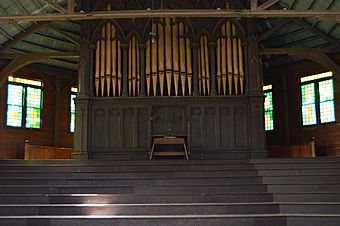Davis-Ferris Organ facts for kids
|
Davis-Ferris Organ
|
|

Front view
|
|
| Location | Round Lake Auditorium, Round Lake, NY |
|---|---|
| Built | 1847 |
| NRHP reference No. | 100000864 |
Quick facts for kids Significant dates |
|
| Added to NRHP | December 23, 2016 |
| Designated NHL | December 23, 2016 |
The Davis-Ferris Organ is a very special musical instrument. It was built way back in 1847. This makes it the oldest large pipe organ in the United States that hasn't been changed much over time.
You can find this amazing organ in the Round Lake Auditorium. This auditorium is in the village of Round Lake, New York. The organ wasn't always there, though! It first lived in the Calvary Church in Manhattan. In 1888, it was moved to Round Lake. There, it was used for summer shows, like the old Chautauqua programs, until the 1920s. Today, the village of Round Lake owns and takes care of this historic organ. In 2016, it was named a National Historic Landmark. This means it's a very important part of American history!
Contents
What Makes the Davis-Ferris Organ Special?
The Davis-Ferris Organ is a large, free-standing instrument. It is housed inside a beautiful wooden case. This case has a cool Gothic style, which means it looks like old European church architecture. Some people think the famous architect James Renwick Jr. might have designed this case. He also designed the Calvary Church where the organ first lived.
The case is huge, about 24 feet tall, 16 feet wide, and 23 feet deep. It acts like a protective box for all the organ's parts. Inside, you'll find three keyboards, called manuals, and a foot pedal board. There's also a system to move air and many wooden and metal pipes.
How Does This Old Organ Work?
Organs need air to make sound. The Davis-Ferris Organ now uses an electric blower to push air through its pipes. This blower was likely added in the early 1900s when the auditorium got electricity. Before that, the organ used a water-powered system to pump air!
Most of the organ's original parts are still there. This includes the mechanical controls, like the stops (which change the sound) and the keyboards. Some small changes were made when it moved to Round Lake. For example, the longest pipes were made a bit shorter to fit the new space. The organ's sound might have also been adjusted after it was installed in its new home.
The Organ's Journey: From Church to Auditorium
Richard M. Ferris built this organ in 1847. He was an organ builder who briefly worked with William H. Davis. That's why the organ is called the Davis-Ferris Organ! It was built for the Calvary Church in Manhattan.
Moving to Round Lake
The organ stayed at the church for about 40 years. But by the 1880s, the church decided the organ didn't fit their services anymore. Around the same time, the Round Lake Methodist camp meeting was changing. It started offering more fun, non-religious summer programs, like the Chautauqua events.
In 1888, the Round Lake leaders decided to offer musical programs. They might have bought the Davis-Ferris Organ because it was available. The organ became a big part of these summer shows. It continued to play music for audiences until the 1920s.
Keeping the Music Alive
After the 1920s, the organ wasn't used as much for about 40 years. But in the 1960s, people became interested in it again. Since then, the village of Round Lake has been working hard. They have been repairing and improving the organ and the auditorium. This helps make sure this amazing historical instrument can keep making music for many more years!



